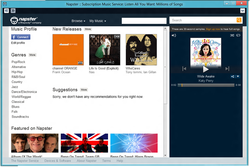Top Qs
Timeline
Chat
Perspective
Napster (pay service)
Napster's music subscription service between 2003–2011; aka Napster 2.0 From Wikipedia, the free encyclopedia
Remove ads
Napster, commonly known as "Napster 2.0",[2][3] was a music streaming service and digital music store, launched by Roxio in 2003 under the purchased name and trademarks of former free peer-to-peer file sharing software Napster in the aftermath of the latter's 2002 bankruptcy and subsequent shut down after a series of legal actions taken by the RIAA.[4] Roxio purchased Napster and a music streaming service called PressPlay in 2003,[3] to create a new legal online music service that lets users access music through a subscription or on a fee-per-song basis. Napster was later acquired by Best Buy. The service was acquired by rival Rhapsody in 2011.
Remove ads
History
Summarize
Perspective
As a Roxio subsidiary
In 2002, Roxio bought the assets of the original Napster at its bankruptcy auction and acquired PressPlay in May 2003 for $40 million.[5] After integrating the services, Roxio launched a revamped Napster in October 2003, whereby users were able to download songs a-la-carte or pay for a monthly unlimited download and streaming media service.[6][7] Users were also able to share playlists and browse other users' libraries.[8]
Napster MP3 player
Soon after launching the revamped Napster, Roxio partnered with Korean electronics maker Samsung to create a Napster-branded MP3 player. The player, named Samsung Napster YP-910 came with a 20GB hard disk that ran for ten hours on a lithium-polymer battery. It used a special version of Napster software and drivers to transfer DRM-protected files to the built-in hard disk.[9]
Free Napster
In May 2006, Napster launched Free Napster, a free, advertising-supported Web-based music player that enabled users to stream full-length versions of all the songs in Napster's catalog of over 8 million tracks three times each, without downloading any software or making any service commitment.[10][11] Visitors could also purchase DRM-free MP3 downloads. It was discontinued in March 2010.[12]
As a Best Buy company
In September 2008, after introducing its Insignia line of portable media players, Best Buy acquired Napster for $121 million. At that time, Napster was incurring significant losses due to new competition and had approximately 760,000 subscribers.[13][14][15] In January 2010, after losing subscribers, the CEO position, held by Chris Gorog, was eliminated.[16]
Purchase by Rhapsody
In 2011, Napster was acquired by competing music streaming provider Rhapsody International.[17] In June 2016, as part of a restructuring, Napster's San Francisco offices were closed, and some employees were laid off.[18] Concurrently, Rhapsody announced that it would rebrand as Napster, citing that the name was better-known internationally.[17][19]
Remove ads
See also
References
External links
Wikiwand - on
Seamless Wikipedia browsing. On steroids.
Remove ads
